Anatomy of Mitral Valve Complex as Revealed by Non-Invasive Imaging: Pathological, Surgical and Interventional Implications
Abstract
1. Introduction
2. Mitral Annulus
Imaging Techniques
3. Mitral Leaflets
Imaging Techniques
4. Chordal Apparatus
Imaging Techniques
5. Papillary Muscles
Imaging Techniques
6. Pathological Implications
6.1. Mitral Annulus
6.1.1. Dilation
6.1.2. Calcifications
6.1.3. MA Disjunction
6.1.4. Endocarditis
6.2. Mitral Leaflets
6.3. Chordae Tendineae
7. Surgical and Interventional Implications
8. Conclusions
Author Contributions
Funding
Conflicts of Interest
References
- Faletra, F.F.; Leo, L.A.; Paiocchi, V.L.; Schlossbauer, S.A.; Pedrazzini, G.; Moccetti, T.; Ho, S.Y. Revisiting Anatomy of the Interatrial Septum and its Adjoining Atrioventricular Junction Using Noninvasive Imaging Techniques. J. Am. Soc Echocardiogr. 2019, 32, 580–592. [Google Scholar] [CrossRef] [PubMed]
- Ho, S.Y.; McCarthy, K.P.; Faletra, F.F. Anatomy of the left atrium for interventional echocardiography. Eur. J. Echocardiogr. 2011, 12, i11–i15. [Google Scholar] [CrossRef] [PubMed]
- Faletra, F.F.; Ho, S.Y.; Regoli, F.; Acena, M.; Auricchio, A. Real-time three-dimensional transesophageal echocardiography in imaging key anatomical structures of the left atrium: Potential role during atrial fibrillation ablation. Heart 2013, 99, 133–142. [Google Scholar] [CrossRef] [PubMed]
- Faletra, F.F.; Muzzarelli, S.; Dequarti, M.C.; Murzilli, R.; Bellu, R.; Ho, S.Y. Imaging-based right-atrial anatomy by computed tomography, magnetic resonance imaging, and three-dimensional transoesophageal echocardiography: Correlations with anatomic specimens. Eur. Heart J. Cardiovasc. Imaging 2013, 14, 1123–1131. [Google Scholar] [CrossRef]
- Faletra, F.F.; Leo, L.A.; Paiocchi, V.L.; Caretta, A.; Viani, G.M.; Schlossbauer, S.A.; Demertzis, S.; Ho, S.Y. Anatomy of mitral annulus insights from non-invasive imaging techniques. Eur. Heart J. Cardiovasc. Imaging 2019, 20, 843–857. [Google Scholar] [CrossRef]
- Muraru, D.; Hahn, R.T.; Soliman, O.I.; Faletra, F.F.; Basso, C.; Badano, L.P. 3-Dimensional Echocardiography in Imaging the Tricuspid Valve. JACC Cardiovasc. Imaging. 2019, 12, 500–515. [Google Scholar] [CrossRef]
- Faletra, F.F.; Ho, S.Y.; Leo, L.A.; Paiocchi, V.L.; Mankad, S.; Vannan, M.; Moccetti, T. Which Cardiac Structure Lies Nearby? Revisiting Two-Dimensional Cross-Sectional Anatomy. J. Am. Soc. Echocardiogr. 2018, 31, 967–975. [Google Scholar] [CrossRef] [PubMed]
- Faletra, F.F.; Leo, L.A.; Paiocchi, V.L.; Schlossbauer, S.A.; Borruso, M.G.; Pedrazzini, G.; Moccetti, T.; Ho, S.Y. Imaging-based tricuspid valve anatomy by computed tomography, magnetic resonance imaging, two and three-dimensional echocardiography: Correlation with anatomic specimen. Eur. Heart J. Cardiovasc. Imaging 2019, 20, 1–13. [Google Scholar] [CrossRef]
- Dal-Bianco, J.P.; Levine, R.A. Anatomy of the mitral valve apparatus: Role of 2D and 3D echocardiography. Cardiol. Clin. 2013, 31, 151–164. [Google Scholar] [CrossRef] [PubMed]
- Perloff, J.K.; Roberts, W.C. The mitral valve apparatus. Functional anatomy of mitral regurgitation. Circulation 1972, 46, 227–239. [Google Scholar] [CrossRef]
- Ho, S.Y. Anatomy of the mitral valve. Heart 2002, 88 (Suppl. 4), iv5–iv10. [Google Scholar] [CrossRef]
- Angelini, A.; Ho, S.Y.; Anderson, R.H.; Becker, A.E.; Davies, M.J. Disjunction of the mitral annulus in floppy mitral valve. N. Engl. J. Med. 1988, 318, 188–189. [Google Scholar]
- Okafor, I.U.; Santhanakrishnan, A.; Raghav, V.S.; Yoganathan, A.P. Role of Mitral Annulus Diastolic Geometry on Intraventricular Filling Dynamics. J. Biomech. Eng. 2015, 137, 121007. [Google Scholar] [CrossRef]
- Deferm, S.; Bertrand, P.B.; Verbrugge, F.H.; Verhaert, D.; Rega, F.; Thomas, J.D.; Vandervoort, P.M. Atrial Functional Mitral Regurgitation: JACC Review Topic of the Week. J. Am. Coll. Cardiol. 2019, 73, 2465–2476. [Google Scholar] [CrossRef]
- Tretter, J.T.; Mori, S.; Saremi, F.; Chikkabyrappa, S.; Thomas, K.; Bu, F.; Loomba1, R.S.; Alsaied, T.; Spicer, D.E.; Anderson, R.H. Variations in rotation of the aortic root and membranous septum with implications for transcatheter valve implantation. Heart 2018, 104, 999–1005. [Google Scholar] [CrossRef] [PubMed]
- Levine, R.A.; Triulzi, M.O.; Harrigan, P.; Weyman, A.E. The relationship of mitral annular shape to the diagnosis of mitral valve prolapse. Circulation 1987, 75, 756–767. [Google Scholar] [CrossRef]
- Salgo, I.S.; Gorman, J.H., III; Gorman, R.C.; Jackson, B.M.; Bowen, F.W.; Plappert, T.; St John Sutton, M.G.; Edmunds, L.H., Jr. Effect of annular shape on leaflet curvature in reducing mitral leaflet stress. Circulation 2002, 106, 711–717. [Google Scholar] [CrossRef]
- Asgar, A.W. Sizing the Mitral Annulus: Is CT the Future? JACC Cardiovasc. Imaging 2016, 9, 281–282. [Google Scholar] [CrossRef]
- Loghin, C.; Loghin, A. Role of imaging in novel mitral technologies-echocardiography and computed tomography. Ann. Cardiothorac. Surg. 2018, 7, 799–811. [Google Scholar] [CrossRef]
- Hedgire, S.; Ghoshhajra, B.; Kalra, M. Dose optimization in cardiac CT. Phys. Med. 2017, 41, 97–103. [Google Scholar] [CrossRef]
- Mathew, R.C.; Löffler, A.I.; Salerno, M. Role of Cardiac Magnetic Resonance Imaging in Valvular Heart Disease: Diagnosis, Assessment, and Management. Curr. Cardiol. Rep. 2018, 20, 119. [Google Scholar] [CrossRef]
- Biaggi, P.; Gruner, C.; Jedrzkiewicz, S.; Karski, J.; Meineri, M.; Vegas, A.; David, T.E.; Woo, A.; Rakowski, H. Assessment of mitral valve prolapse by 3D TEE angled views are key. JACC Cardiovasc. Imaging 2011, 4, 94–97. [Google Scholar] [CrossRef] [PubMed][Green Version]
- Gunnal, S.A.; Wabale, R.N.; Farooqui, M.S. Morphological study of chordae tendinae in human cadaveric hearts. Heart Views 2015, 16, 1–12. [Google Scholar] [CrossRef]
- Padala, M.; Sacks, M.S.; Liou, S.W.; Balachandran, K.; He, Z.M.; Yoganathan, A.P. Mechanics of the mitral valve strut chordae insertion region. J. Biomech. Eng. 2010, 132, 081004. [Google Scholar] [CrossRef]
- Faletra, F.F.; Ramamurthi, A.; Dequarti, M.C.; Leo, L.A.; Moccetti, T.; Pandian, N. Artefacts in three-dimensional transesophageal echocardiography. J. Am. Soc. Echocardiogr. 2014, 27, 453–462. [Google Scholar] [CrossRef]
- Estes, E.H.; Dalton, F.M.; Entman, M.L.; DixonII, H.B.; Hackel, D.B. The anatomy and blood supply of the papillary muscles of the left ventricle. Am. Heart J. 1966, 71, 356–362. [Google Scholar] [CrossRef]
- Ranganathan, N.; Burch, G.E. Gross morphology and arterial supply of the papillary muscles of the left ventricle of man. Am. Heart J. 1969, 77, 506–516. [Google Scholar] [CrossRef]
- Axel, L. Papillary muscles do not attach directly to the solid heart wall. Circulation 2004, 109, 3145–3148. [Google Scholar] [CrossRef]
- Abramowitz, Y.; Jilaihawi, H.; Chakravarty, T.; Mack, M.J.; Makkar, R.R. Mitral Annulus Calcification. J. Am. Coll. Cardiol. 2015, 66, 1934–1941. [Google Scholar] [CrossRef]
- Hutchins, G.M.; Moore, G.W.; Skoog, D.K. The association of floppy mitral valve with disjunction of the mitral annulus fibrosus. N. Engl. J. Med. 1986, 314, 535–540. [Google Scholar] [CrossRef]
- Marra, M.P.; Basso, C.; De Lazzari, M.; Rizzo, S.; Cipriani, A.; Giorgi, B.; Lacognata, C.; Rigato, I.; Migliore, F.; Pilichou, K.; et al. Morphofunctional Abnormalities of Mitral Annulus and Arrhythmic Mitral Valve Prolapse. Circ. Cardiovasc. Imaging 2016, 9, e005030. [Google Scholar] [CrossRef]
- Basso, C.; Perazzolo Marra, M. Mitral Annulus Disjunction: Emerging Role of Myocardial Mechanical Stretch in Arrhythmogenesis. J. Am. Coll. Cardiol. 2018, 72, 1610–1612. [Google Scholar] [CrossRef] [PubMed]
- Dejgaard, L.A.; Skjølsvik, E.T.; Lie, Ø.H.; Ribe, M.; Stokke, M.K.; Hegbom, F.; Scheirlynck, E.S.; Gjertsen, E.; Andresen, K.; Helle-Valle, T.M.; et al. The Mitral Annulus Disjunction Arrhythmic Syndrome. J. Am. Coll. Cardiol. 2018, 72, 1600–1609. [Google Scholar] [CrossRef]
- Kirali, K.; Sarikaya, S.; Ozen, Y.; Sacli, H.; Basaran, E.; Yerlikhan, O.A.; Aydin, E.; Rabus, M.B. Surgery for Aortic Root Abscess: A 15-Year Experience. Tex Heart Inst. J. 2016, 43, 20–28. [Google Scholar] [CrossRef]
- Sudhakar, S.; Sewani, A.; Agrawal, M.; Uretsky, B.F. Pseudoaneurysm of the mitral-aortic intervalvular fibrosa (MAIVF): A comprehensive review. J. Am. Soc. Echocardiogr. 2010, 23, 1009–1018. [Google Scholar] [CrossRef]
- Asgar, A.W.; Mack, M.J.; Stone, G.W. Secondary mitral regurgitation in heart failure: Pathophysiology, prognosis, and therapeutic considerations. J. Am. Coll. Cardiol. 2015, 65, 1231–1248. [Google Scholar] [CrossRef]
- Dal-Bianco, J.P.; Aikawa, E.; Bischoff, J.; Guerrero, J.L.; Handschumacher, M.D.; Sullivan, S.; Johnson, B.; Titus, J.S.; Iwamoto, Y.; Wylie-Sears, J.; et al. Active adaptation of the tethered mitral valve: Insights into a compensatory mechanism for functional mitral regurgitation. Circulation 2009, 120, 334–342. [Google Scholar] [CrossRef] [PubMed]
- Dal-Bianco, J.P.; Aikawa, E.; Bischoff, J.; Guerrero, J.L.; Hjortnaes, J.; Beaudoin, J.; Szymanski, C.; Bartko, P.E.; Seybolt, M.M.; Handschumacher, M.D.; et al. Transatlantic Mitral Network. Myocardial Infarction Alters Adaptation of the Tethered Mitral Valve. J. Am. Coll. Cardiol. 2016, 67, 275–287. [Google Scholar] [CrossRef]
- Nielsen, S.L.; Timek, T.A.; Green, G.R.; Dagum, P.; Daughters, G.T.; Hasenkam, J.M.; Bolger, A.F.; Ingels, N.B.; Miller, D.C. Influence of anterior mitral leaflet second-order chordae tendineae on left ventricular systolic function. Circulation 2003, 108, 486–491. [Google Scholar] [CrossRef]
- Varma, P.K.; Krishna, N.; Jose, R.L.; Madkaiker, A.N. Ischemic mitral regurgitation. Ann. Card. Anaesth. 2017, 20, 432–439. [Google Scholar] [CrossRef]
- Messas, E.; Guerrero, J.L.; Handschumacher, M.D.; Conrad, C.; Chow, C.M.; Sullivan, S.; Yoganathan, A.P.; Levine, R.A. Chordal cutting: A new therapeutic approach for ischemic mitral regurgitation. Circulation 2001, 104, 1958–1963. [Google Scholar] [CrossRef]
- Messas, E.; Pouzet, B.; Touchot, B.; Guerrero, J.L.; Vlahakes, G.J.; Desnos, M.; Menasché, P.; Hagege, A.; Levine, R.A. Efficacy of chordal cutting to relieve chronic persistent ischemic mitral regurgitation. Circulation 2003, 108 (Suppl. 1), II111–II115. [Google Scholar] [CrossRef][Green Version]
- Carpentier, A. Cardiac valve surgery—The “French correction”. J. Thorac. Cardiovasc. Surg. 1983, 86, 323–337. [Google Scholar] [CrossRef]
- Del Forno, B.; Castiglioni, A.; Sala, A.; Geretto, A.; Giacomini, A.; Denti, P.; Bonis, M.D.; Alfieri, O. Mitral valve annuloplasty. Multimed. Man Cardiothorac. Surg. 2017, 2017. [Google Scholar] [CrossRef]
- Van Mieghem, N.M.; Piazza, N.; Anderson, R.H.; Tzikas, A.; Nieman, K.; De Laat, L.E.; McGhie, J.S.; Geleijnse, M.L.; Feldman, T.; Serruys, P.W.; et al. Anatomy of the mitral valvular complex and its implications for transcatheter interventions for mitral regurgitation. J. Am. Coll. Cardiol. 2010, 56, 617–626. [Google Scholar] [CrossRef] [PubMed]
- Anderson, R.H.; Ho, S.Y.; Becker, A.E. The surgical anatomy of the conduction tissues. Thorax 1983, 38, 408–420. [Google Scholar] [CrossRef]
- Miller, M.; Thourani, V.H.; Whisenant, B. The Cardioband transcatheter annular reduction system. Ann. Cardiothorac. Surg. 2018, 7, 741–747. [Google Scholar] [CrossRef]
- Ferrero Guadagnoli, A.; De Carlo, C.; Maisano, F.; Ho, E.; Saccocci, M.; Cuevas, O.; Luciani, M.; Kuwata, S.; Nietlispach, F.; Taramasso, M. Cardioband system as a treatment for functional mitral regurgitation. Expert Rev. Med. Devices 2018, 15, 415–421. [Google Scholar] [CrossRef]
- Miura, M.; Zuber, M.; Gavazzoni, M.; Lin, S.I.; Pozzoli, A.; Taramasso, M.; Maisano, F. Possible left circumflex artery obstruction in a cardioband transcatheter mitral annuloplasty caused by coronary kinking during cinching. JACC Cardiovasc. Interv. 2019, 12, 600–601. [Google Scholar] [CrossRef]
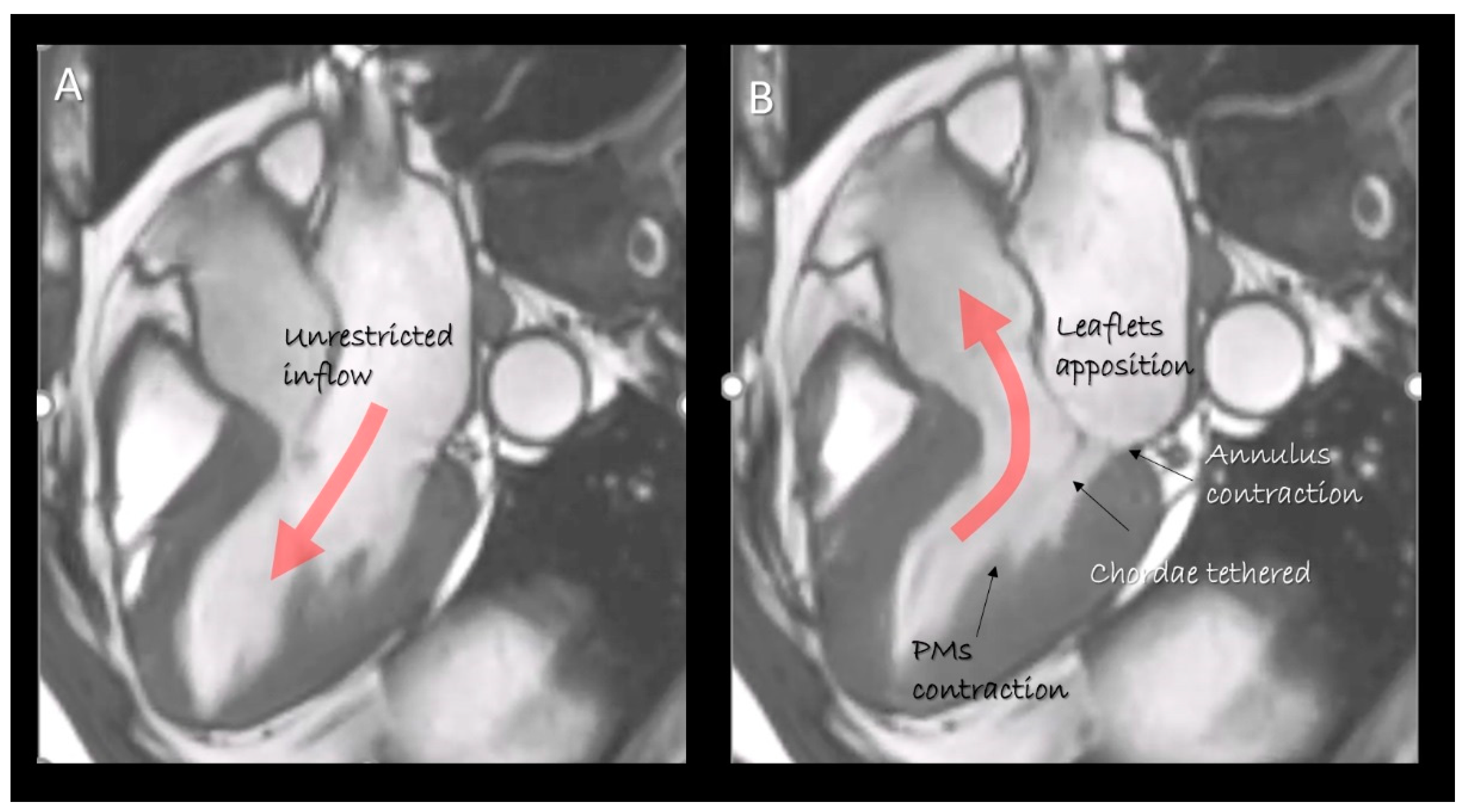
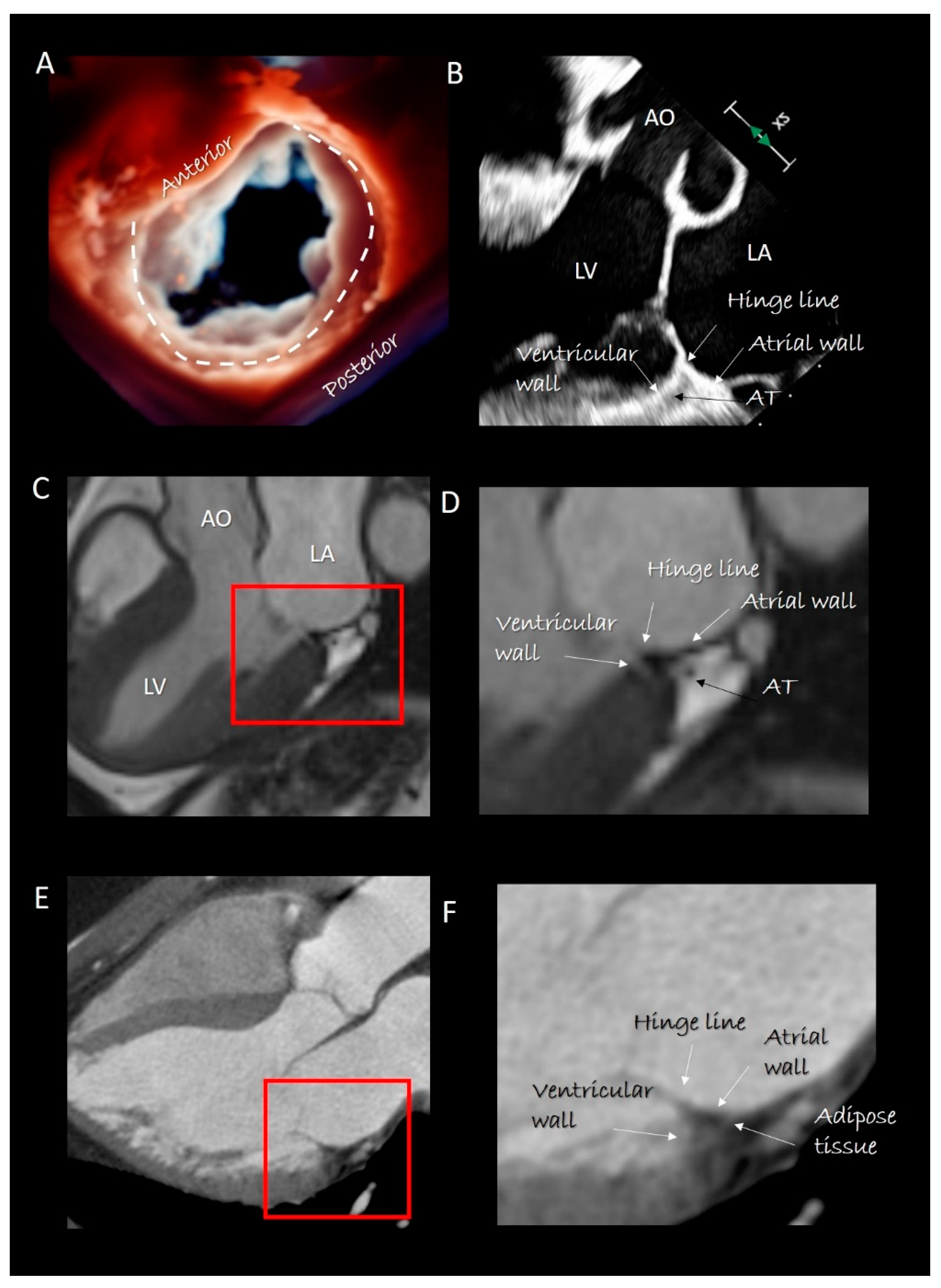
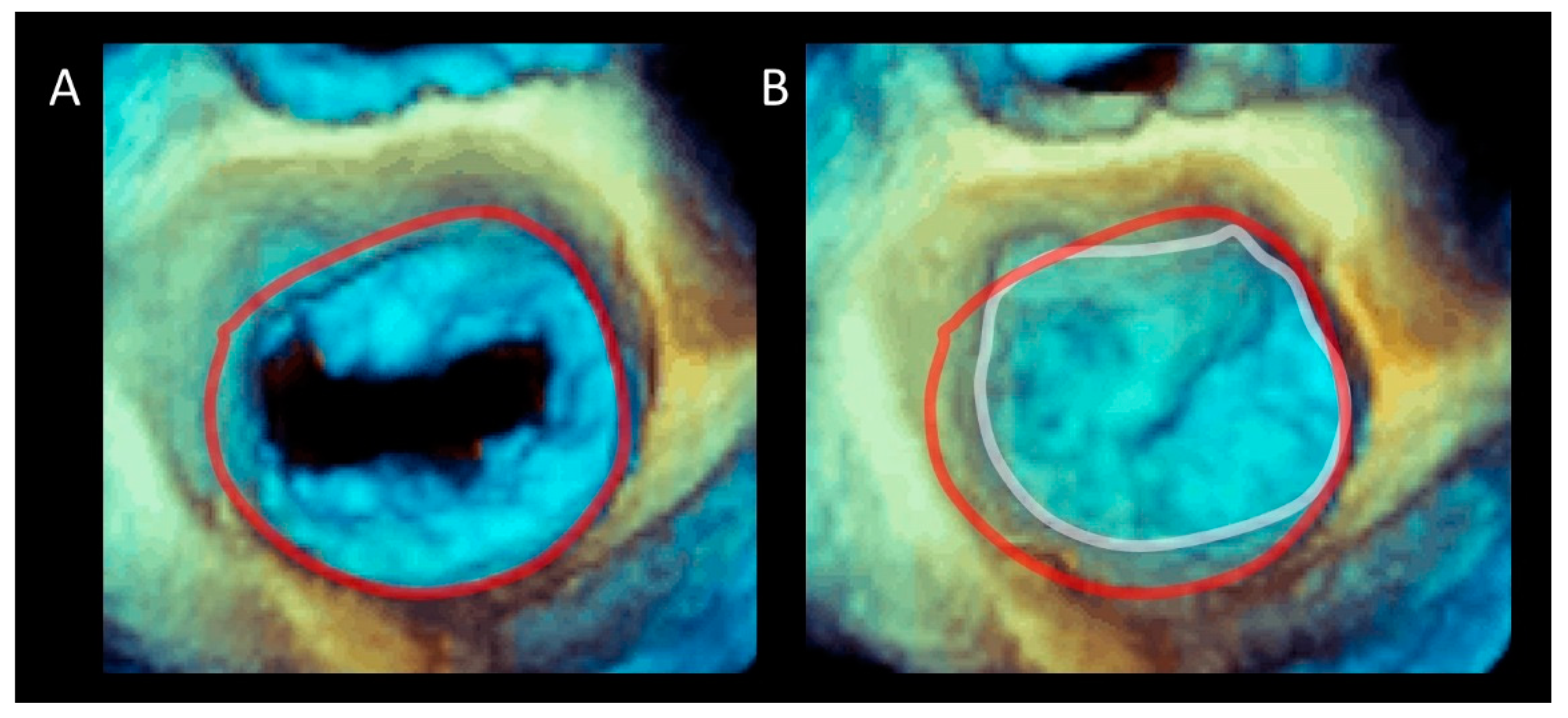
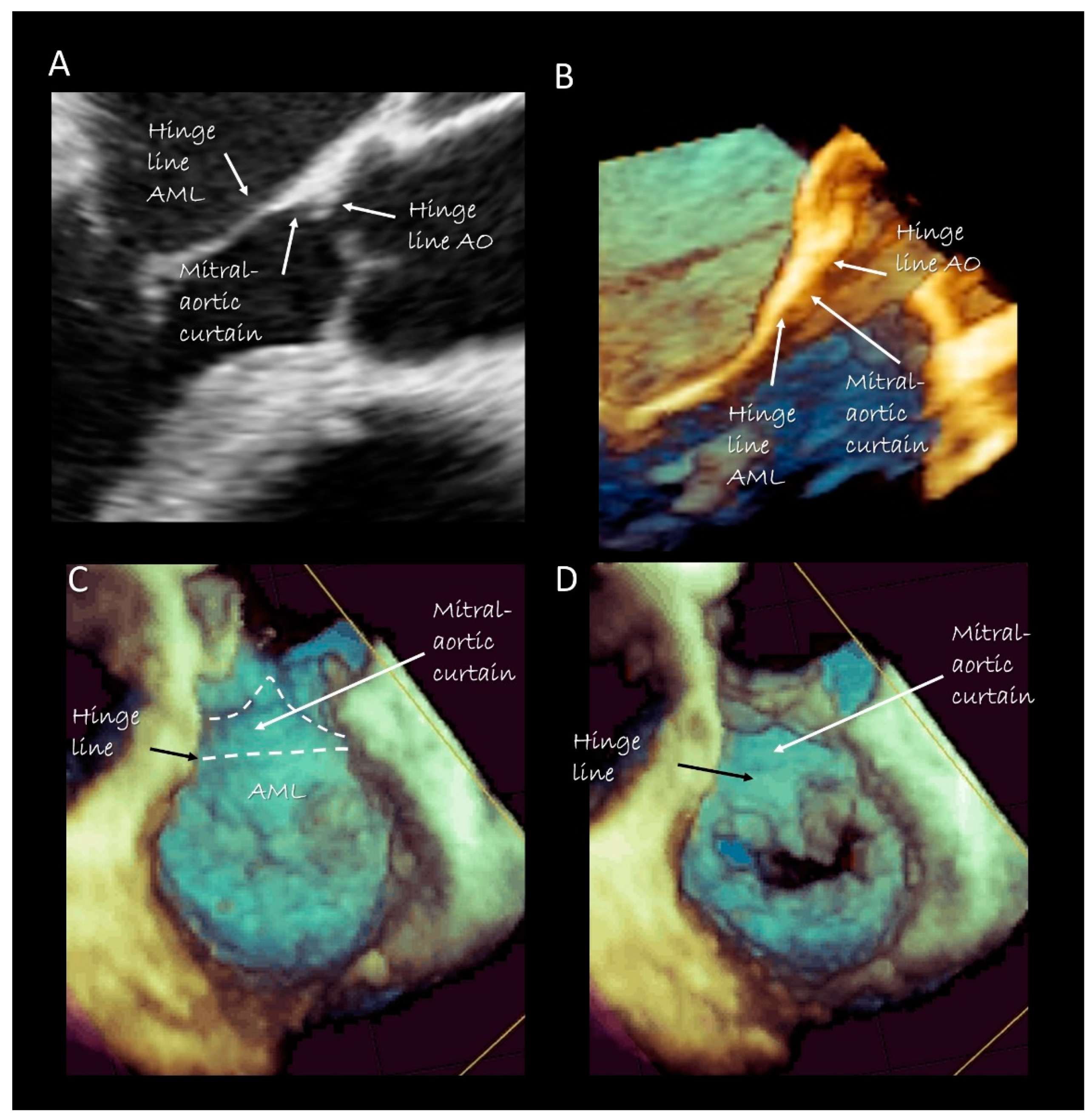
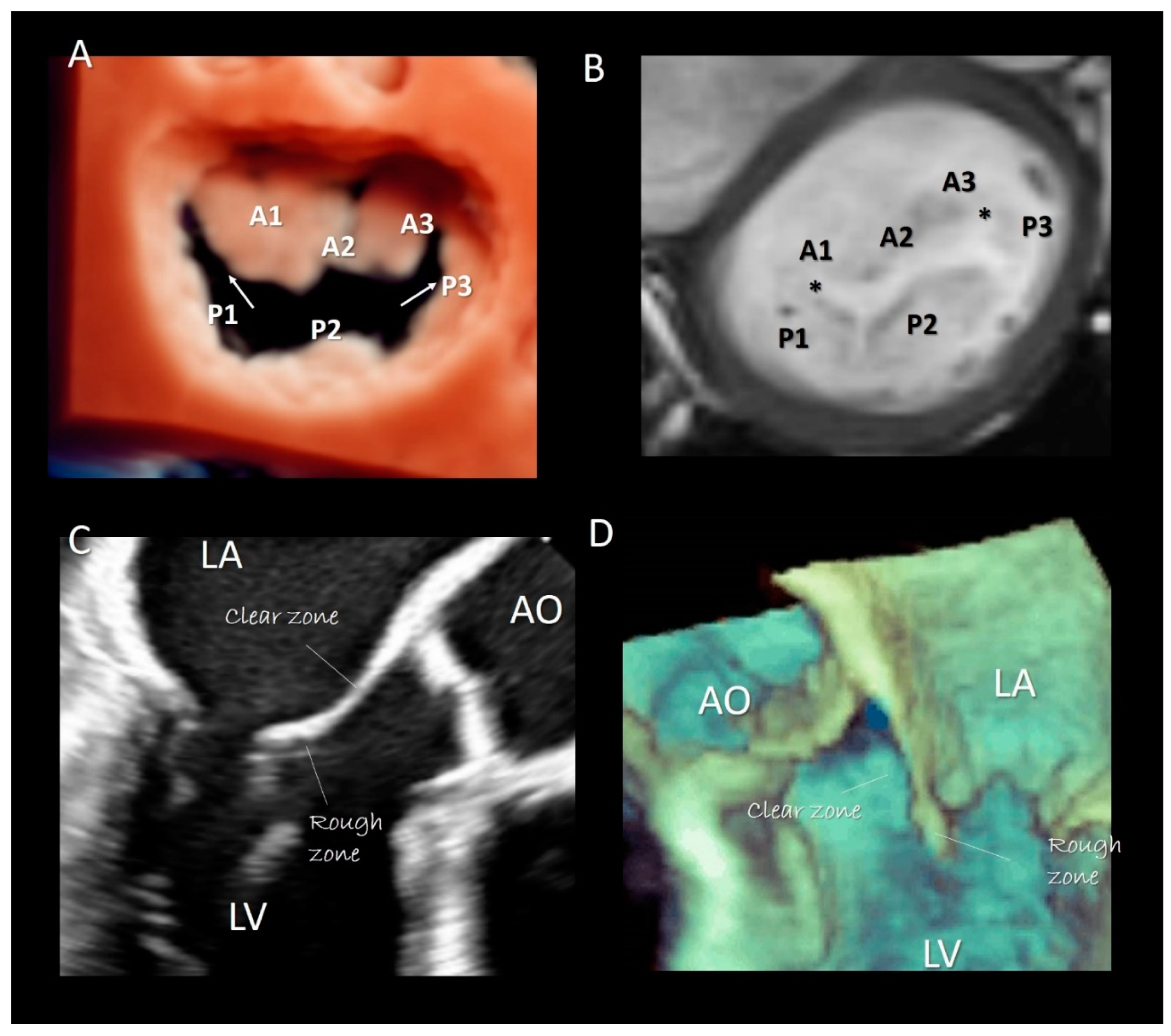

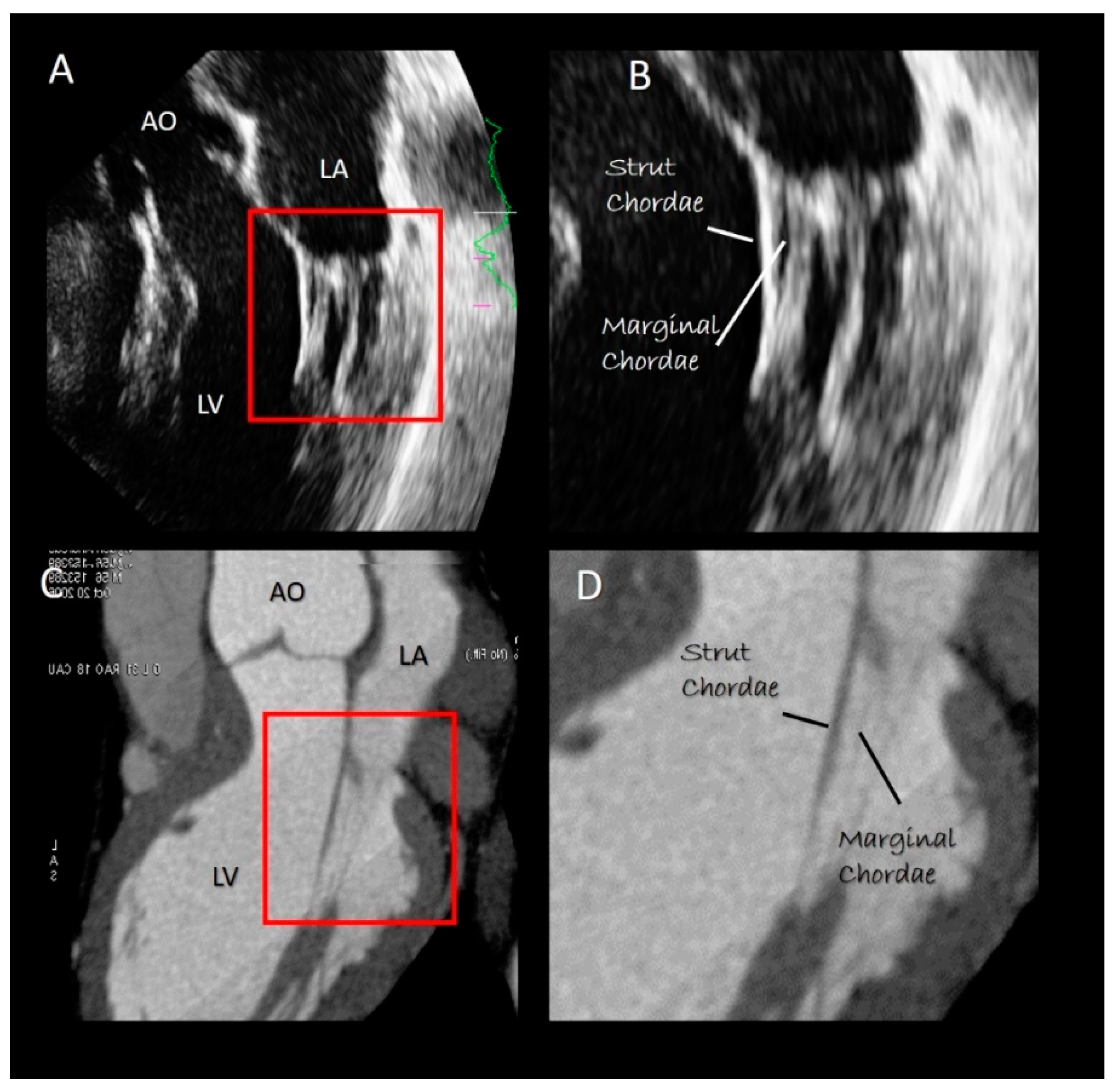

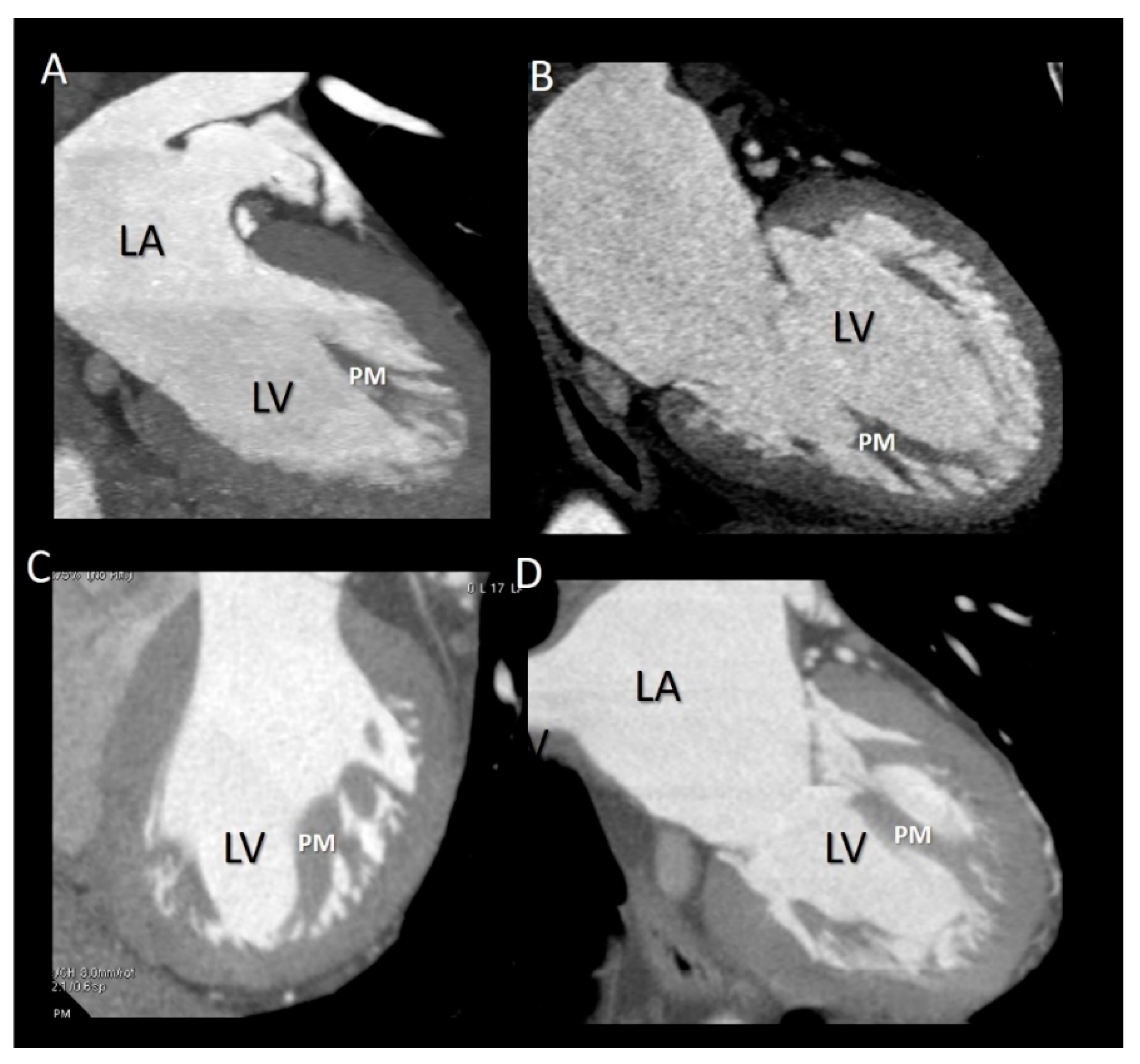

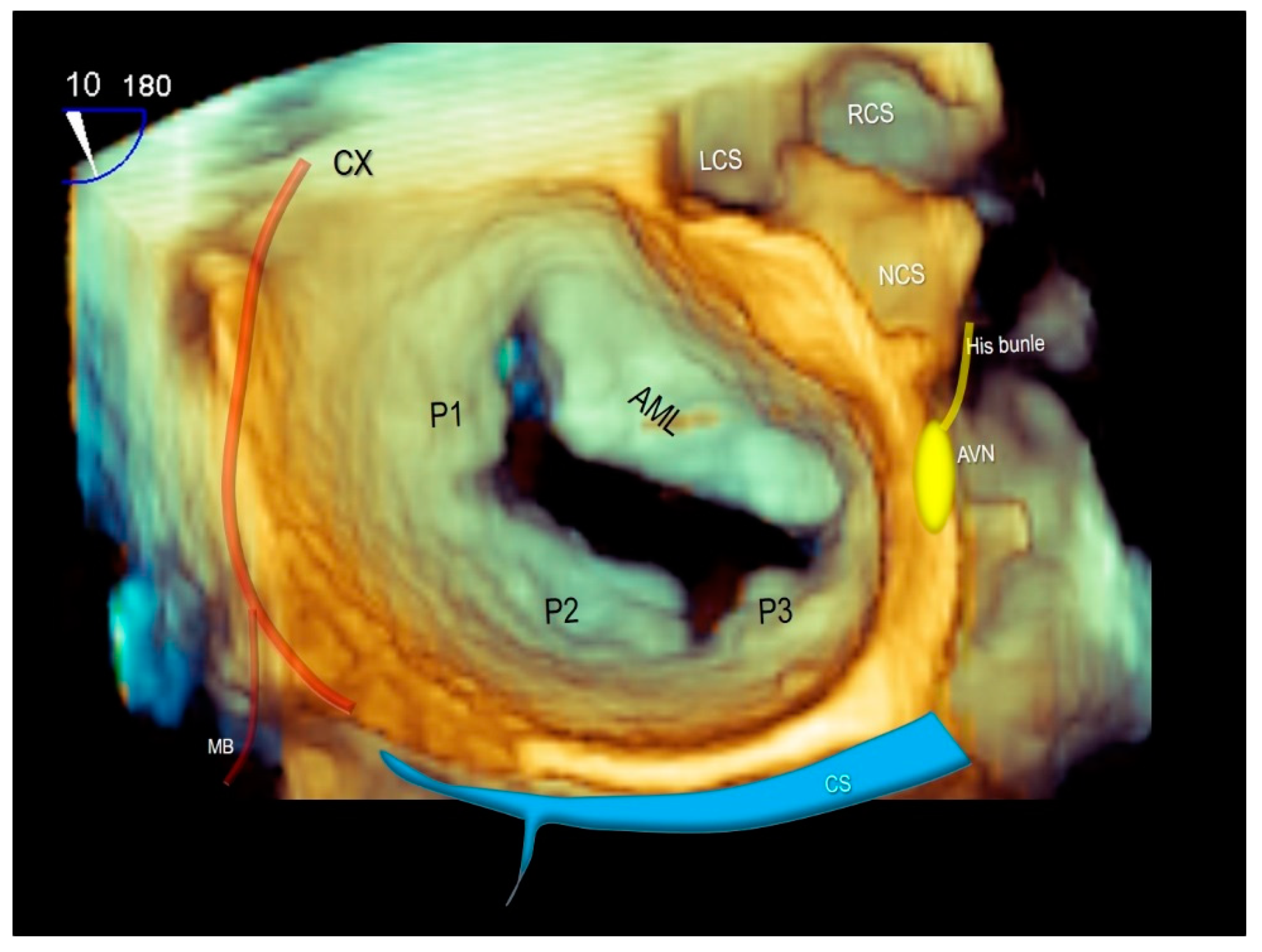
Publisher’s Note: MDPI stays neutral with regard to jurisdictional claims in published maps and institutional affiliations. |
© 2020 by the authors. Licensee MDPI, Basel, Switzerland. This article is an open access article distributed under the terms and conditions of the Creative Commons Attribution (CC BY) license (http://creativecommons.org/licenses/by/4.0/).
Share and Cite
Leo, L.A.; Paiocchi, V.L.; Schlossbauer, S.A.; Gherbesi, E.; Faletra, F.F. Anatomy of Mitral Valve Complex as Revealed by Non-Invasive Imaging: Pathological, Surgical and Interventional Implications. J. Cardiovasc. Dev. Dis. 2020, 7, 49. https://doi.org/10.3390/jcdd7040049
Leo LA, Paiocchi VL, Schlossbauer SA, Gherbesi E, Faletra FF. Anatomy of Mitral Valve Complex as Revealed by Non-Invasive Imaging: Pathological, Surgical and Interventional Implications. Journal of Cardiovascular Development and Disease. 2020; 7(4):49. https://doi.org/10.3390/jcdd7040049
Chicago/Turabian StyleLeo, Laura Anna, Vera Lucia Paiocchi, Susanne Anna Schlossbauer, Elisa Gherbesi, and Francesco F. Faletra. 2020. "Anatomy of Mitral Valve Complex as Revealed by Non-Invasive Imaging: Pathological, Surgical and Interventional Implications" Journal of Cardiovascular Development and Disease 7, no. 4: 49. https://doi.org/10.3390/jcdd7040049
APA StyleLeo, L. A., Paiocchi, V. L., Schlossbauer, S. A., Gherbesi, E., & Faletra, F. F. (2020). Anatomy of Mitral Valve Complex as Revealed by Non-Invasive Imaging: Pathological, Surgical and Interventional Implications. Journal of Cardiovascular Development and Disease, 7(4), 49. https://doi.org/10.3390/jcdd7040049




